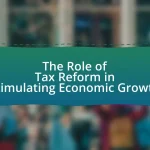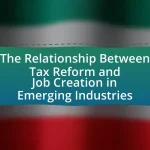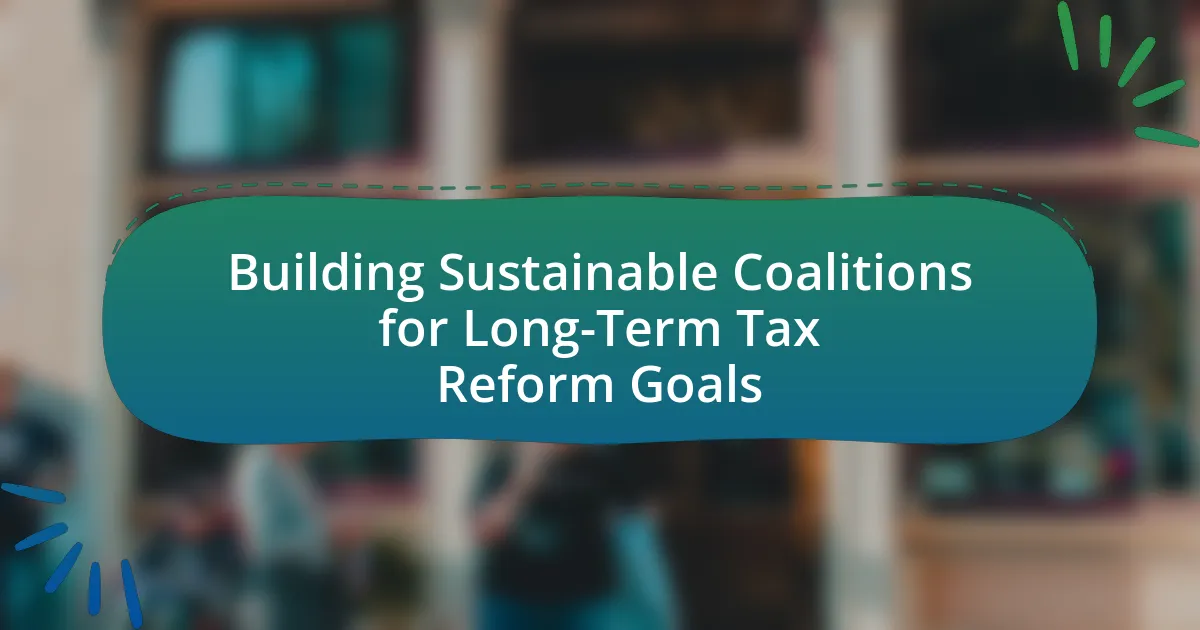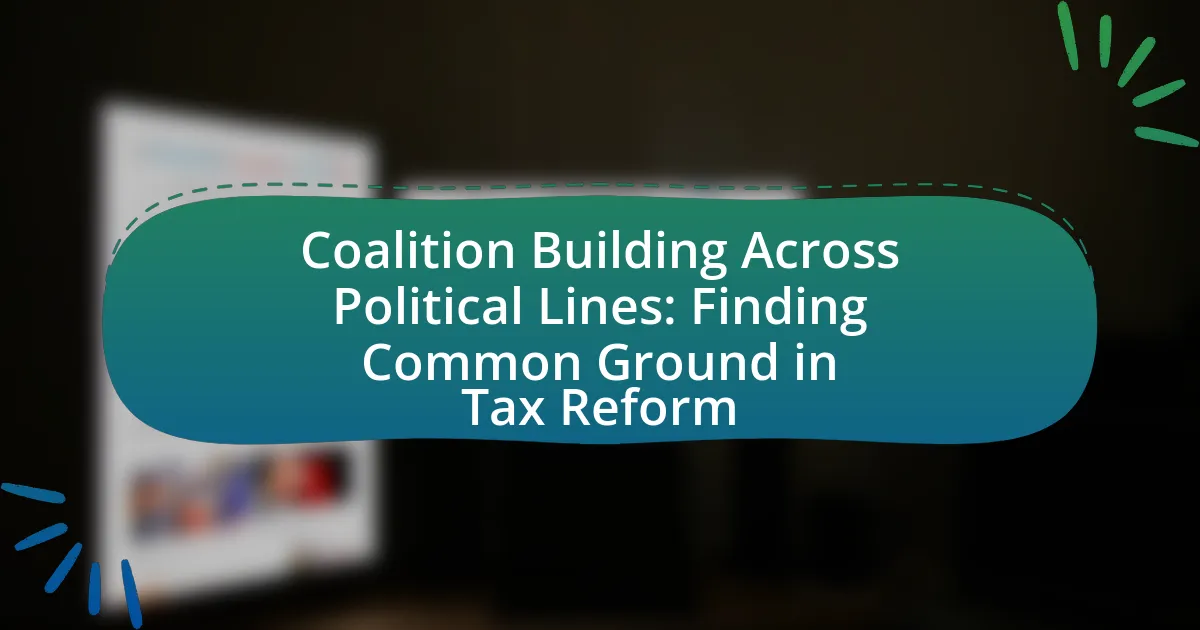Engaging diverse stakeholders in tax reform is a critical process that involves the active participation of various groups, including government entities, businesses, non-profit organizations, and community members, in shaping tax policies. This article outlines the importance of stakeholder engagement in creating equitable and effective tax systems, emphasizing the need for inclusivity, shared goals, and effective communication. It discusses the types of stakeholders typically involved, the influence of their engagement on policy outcomes, and the principles of coalition building. Additionally, the article addresses challenges in stakeholder engagement, strategies for fostering collaboration, and best practices for maintaining involvement over time, ultimately highlighting the significance of diverse perspectives in achieving successful tax reform initiatives.
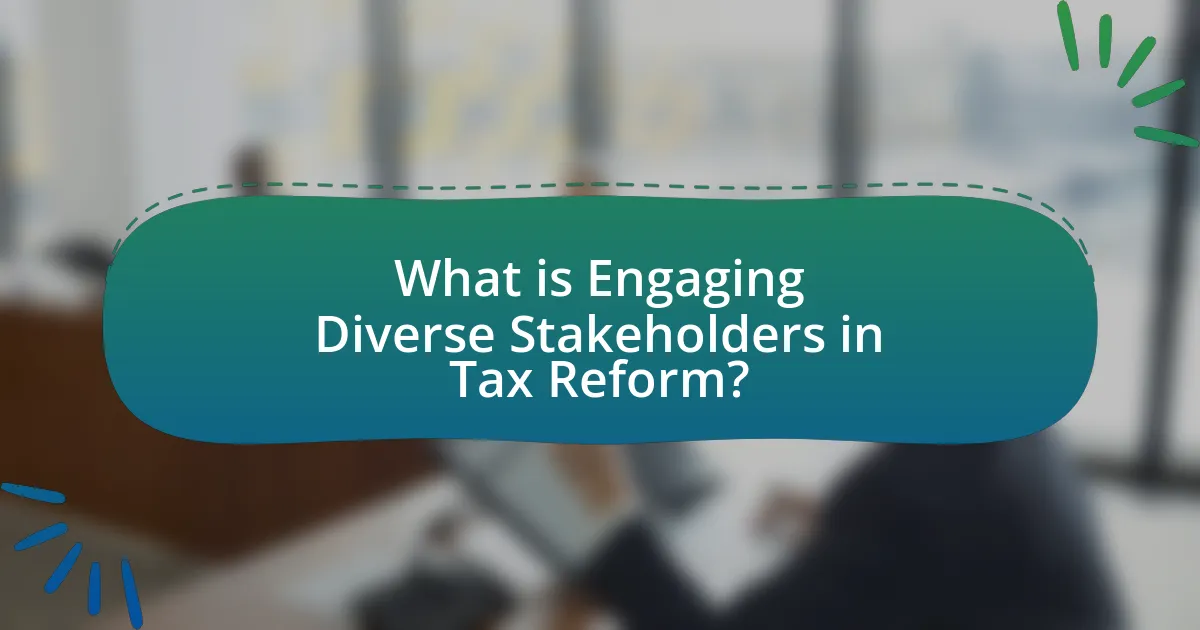
What is Engaging Diverse Stakeholders in Tax Reform?
Engaging diverse stakeholders in tax reform involves actively involving various groups, including government entities, businesses, non-profit organizations, and community members, in the decision-making process regarding tax policies. This engagement is crucial because it ensures that the perspectives and needs of different segments of society are considered, leading to more equitable and effective tax systems. Research indicates that inclusive stakeholder engagement can enhance the legitimacy of tax reforms and improve compliance rates, as stakeholders are more likely to support policies they helped shape.
Why is stakeholder engagement crucial in tax reform initiatives?
Stakeholder engagement is crucial in tax reform initiatives because it ensures that diverse perspectives are considered, leading to more equitable and effective policies. Engaging stakeholders, such as businesses, community organizations, and citizens, fosters transparency and builds trust, which are essential for the successful implementation of tax reforms. Research indicates that inclusive processes can enhance the legitimacy of tax systems, as evidenced by the World Bank’s findings that stakeholder involvement can improve compliance and reduce tax evasion. By incorporating feedback from various groups, policymakers can identify potential issues early, leading to more sustainable and widely accepted tax reforms.
What types of stakeholders are typically involved in tax reform?
Tax reform typically involves a variety of stakeholders, including government officials, policymakers, business leaders, tax professionals, advocacy groups, and the general public. Government officials and policymakers are crucial as they draft and implement tax legislation. Business leaders provide insights on how tax changes affect economic growth and job creation. Tax professionals, such as accountants and tax advisors, offer expertise on compliance and implications of tax policies. Advocacy groups represent specific interests, such as low-income families or environmental concerns, influencing the reform agenda. The general public’s opinions and needs are also vital, as they are directly affected by tax policies. Each of these stakeholders plays a significant role in shaping tax reform discussions and outcomes.
How does stakeholder engagement influence tax policy outcomes?
Stakeholder engagement significantly influences tax policy outcomes by ensuring that diverse perspectives are considered in the decision-making process. Engaging stakeholders, such as businesses, community organizations, and citizens, allows policymakers to gather valuable insights and identify potential impacts of tax policies on various groups. For instance, research by the OECD highlights that inclusive stakeholder engagement can lead to more equitable tax systems and improved compliance rates, as stakeholders feel their voices are heard and their concerns addressed. This collaborative approach not only enhances the legitimacy of tax policies but also fosters trust between the government and the public, ultimately leading to more effective and sustainable tax reforms.
What are the key principles of coalition building in tax reform?
The key principles of coalition building in tax reform include inclusivity, shared goals, effective communication, and trust-building. Inclusivity ensures that diverse stakeholders, such as policymakers, businesses, and community organizations, are represented, which enhances the legitimacy of the reform process. Shared goals align the interests of various groups, fostering collaboration and commitment to the reform initiative. Effective communication facilitates transparency and understanding among stakeholders, which is crucial for addressing concerns and building consensus. Trust-building is essential for maintaining long-term relationships and ensuring that all parties feel valued and heard throughout the reform process. These principles are supported by successful case studies, such as the coalition efforts in the 2017 U.S. tax reform, which highlighted the importance of stakeholder engagement and collaboration in achieving comprehensive tax policy changes.
How can diverse perspectives enhance coalition effectiveness?
Diverse perspectives enhance coalition effectiveness by fostering innovative solutions and improving decision-making processes. When individuals from varied backgrounds and experiences collaborate, they bring unique insights that can identify potential challenges and opportunities that a homogenous group might overlook. Research indicates that diverse teams are 35% more likely to outperform their less diverse counterparts, as they leverage a broader range of ideas and approaches. This diversity not only enriches discussions but also promotes a more comprehensive understanding of the issues at hand, leading to more robust and inclusive policy outcomes in tax reform initiatives.
What strategies can be employed to foster collaboration among stakeholders?
To foster collaboration among stakeholders, implementing structured communication channels is essential. These channels facilitate regular updates and feedback, ensuring all parties are informed and engaged. For instance, utilizing collaborative platforms like Slack or Microsoft Teams can enhance real-time communication and document sharing, which has been shown to improve project outcomes by 25% according to a study by McKinsey & Company. Additionally, establishing clear roles and responsibilities helps to align stakeholder expectations and accountability, further promoting a collaborative environment. Regular stakeholder meetings, both virtual and in-person, can also strengthen relationships and build trust, which is critical for successful coalition building in tax reform initiatives.
What challenges arise in engaging diverse stakeholders for tax reform?
Engaging diverse stakeholders for tax reform presents challenges such as differing priorities, communication barriers, and power imbalances. Stakeholders, including government entities, businesses, and community organizations, often have conflicting interests that complicate consensus-building. For instance, businesses may prioritize lower tax rates to enhance profitability, while social organizations may advocate for increased taxes to fund public services. Communication barriers arise from varying levels of understanding about tax policy, leading to misinterpretations and disengagement. Additionally, power imbalances can skew discussions, where more influential stakeholders dominate the conversation, marginalizing less powerful voices. These factors collectively hinder effective collaboration and the development of equitable tax reform solutions.
How can conflicting interests among stakeholders be managed?
Conflicting interests among stakeholders can be managed through effective communication and negotiation strategies. Establishing open lines of communication allows stakeholders to express their concerns and priorities, fostering an environment of trust. Utilizing negotiation techniques, such as interest-based bargaining, helps identify common ground and develop mutually beneficial solutions. Research indicates that collaborative approaches, like stakeholder workshops and consensus-building sessions, can significantly reduce tensions and lead to more sustainable outcomes in coalition building, particularly in complex areas like tax reform.
What role does communication play in overcoming engagement barriers?
Communication is essential in overcoming engagement barriers as it facilitates understanding, builds trust, and fosters collaboration among diverse stakeholders. Effective communication strategies, such as active listening and clear messaging, help to identify and address the specific concerns and needs of different groups, thereby reducing misunderstandings and resistance. Research indicates that organizations that prioritize transparent communication experience higher levels of stakeholder engagement, as evidenced by a study from the International Association for Public Participation, which found that inclusive communication practices significantly enhance participation rates in community initiatives.
How can we transition from broad engagement strategies to specific actions?
To transition from broad engagement strategies to specific actions, organizations must first identify key stakeholders and their unique interests. This targeted approach allows for the development of tailored initiatives that address specific needs and concerns. For example, a coalition focused on tax reform can conduct stakeholder mapping to prioritize engagement efforts, ensuring that actions align with the interests of influential groups. Research shows that targeted engagement increases participation rates by up to 40%, demonstrating the effectiveness of this method in mobilizing stakeholders toward actionable outcomes.
What are the next steps in building a coalition for tax reform?
The next steps in building a coalition for tax reform include identifying key stakeholders, establishing common goals, and creating a strategic communication plan. Identifying stakeholders involves engaging various groups such as policymakers, business leaders, and community organizations to ensure diverse perspectives are included. Establishing common goals requires consensus on the desired outcomes of tax reform, which can be achieved through collaborative discussions and workshops. Creating a strategic communication plan is essential for effectively conveying the coalition’s objectives and mobilizing support, utilizing data and research to back the proposed reforms. These steps are critical for fostering collaboration and ensuring the coalition’s success in advocating for tax reform.
What specific tactics can be used to engage stakeholders effectively?
To engage stakeholders effectively, utilize tactics such as active listening, transparent communication, and collaborative decision-making. Active listening involves genuinely understanding stakeholders’ concerns and feedback, which fosters trust and encourages participation. Transparent communication ensures that stakeholders are informed about processes, decisions, and changes, thereby reducing uncertainty and resistance. Collaborative decision-making invites stakeholders to contribute to the planning and implementation phases, enhancing their commitment and ownership of the outcomes. Research indicates that organizations employing these tactics experience higher stakeholder satisfaction and engagement levels, as evidenced by a study published in the Journal of Business Research, which found that effective stakeholder engagement strategies lead to improved project success rates.
How can technology facilitate stakeholder engagement in tax reform?
Technology can facilitate stakeholder engagement in tax reform by providing platforms for communication, collaboration, and data sharing. Digital tools such as online forums, social media, and webinars enable stakeholders to express their views, share insights, and participate in discussions regardless of geographical barriers. For instance, the use of collaborative software allows for real-time feedback and input from diverse groups, ensuring that various perspectives are considered in the reform process. Additionally, data analytics can help identify stakeholder needs and preferences, enhancing targeted outreach efforts. Research indicates that inclusive engagement through technology can lead to more informed policy decisions and increased public trust in tax reforms.
What are best practices for maintaining stakeholder involvement over time?
Best practices for maintaining stakeholder involvement over time include regular communication, active engagement, and feedback mechanisms. Regular communication ensures stakeholders are informed about developments and changes, fostering a sense of inclusion. Active engagement involves involving stakeholders in decision-making processes, which enhances their commitment and investment in the outcomes. Implementing feedback mechanisms allows stakeholders to express their concerns and suggestions, demonstrating that their input is valued and considered. Research indicates that organizations that prioritize these practices experience higher levels of stakeholder satisfaction and retention, as evidenced by a study published in the Journal of Business Research, which found that effective stakeholder engagement strategies lead to improved project outcomes and stronger relationships.
What are the common pitfalls in coalition building for tax reform?
Common pitfalls in coalition building for tax reform include lack of clear objectives, insufficient stakeholder engagement, and failure to address conflicting interests. Without clear objectives, coalitions may struggle to maintain focus and direction, leading to ineffective strategies. Insufficient engagement with diverse stakeholders can result in missed opportunities for collaboration and support, as seen in various tax reform initiatives where key groups were overlooked. Additionally, failing to address conflicting interests among coalition members can create tensions and hinder progress, as evidenced by past reform efforts that faltered due to internal disagreements.
How can these pitfalls be avoided to ensure successful engagement?
To avoid pitfalls in engaging diverse stakeholders for successful coalition building in tax reform, it is essential to establish clear communication channels and foster an inclusive environment. Clear communication ensures that all stakeholders understand the objectives and processes involved, reducing misunderstandings that can lead to disengagement. Fostering an inclusive environment encourages participation from all groups, ensuring that diverse perspectives are valued and considered. Research indicates that inclusive practices lead to higher engagement levels, as seen in studies by the Harvard Business Review, which highlight that diverse teams are more innovative and effective in problem-solving.
What practical tips can enhance stakeholder engagement in tax reform?
To enhance stakeholder engagement in tax reform, it is essential to establish clear communication channels. Effective communication fosters transparency and builds trust among stakeholders, which is crucial for collaboration. Engaging stakeholders early in the reform process allows for their input and concerns to be addressed, leading to more inclusive and accepted outcomes. Additionally, utilizing diverse engagement methods, such as workshops, surveys, and public forums, ensures that various perspectives are considered. Research indicates that inclusive stakeholder engagement can lead to more effective policy outcomes, as seen in successful tax reforms in countries like New Zealand, where stakeholder involvement significantly shaped the final policy.

